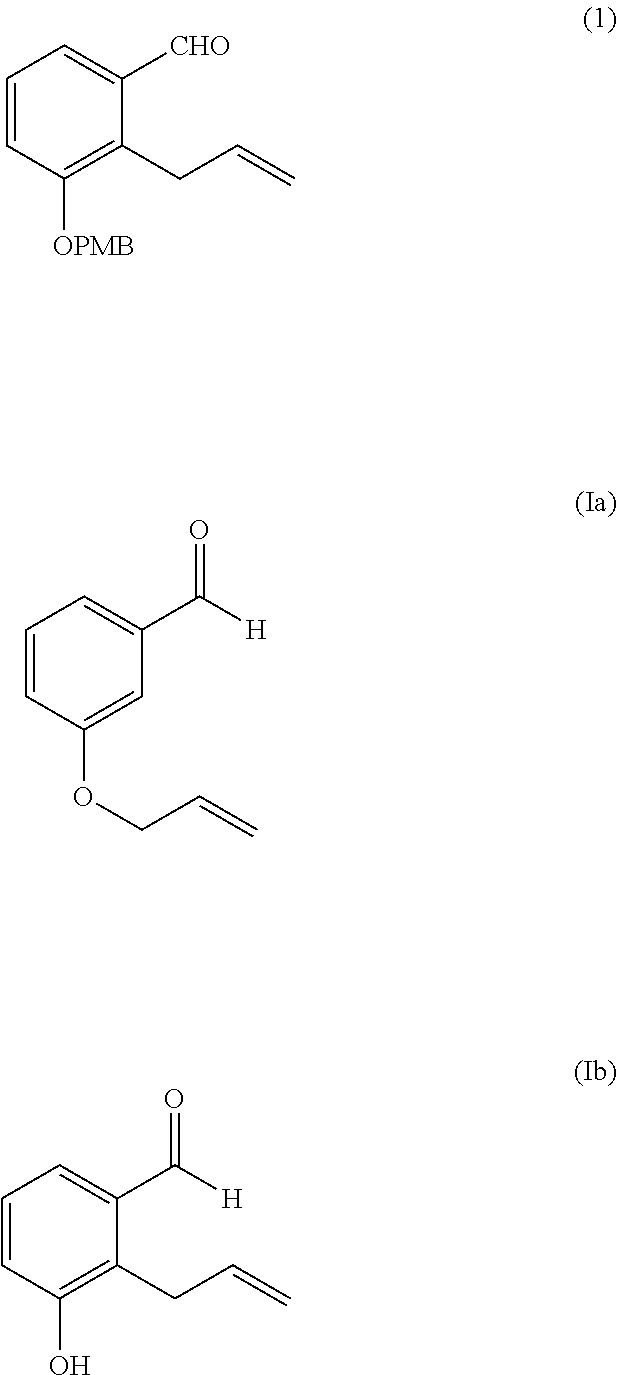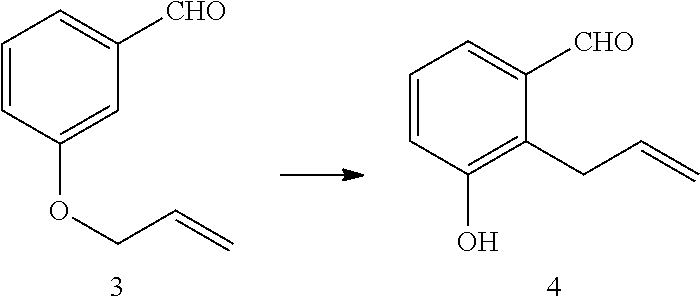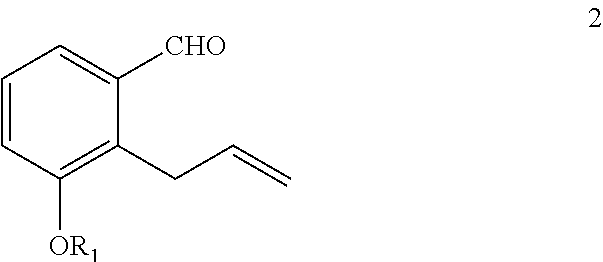Protected aldehydes for use as intermediates in chemical syntheses, and processes for their preparation
a technology of aldehyde and intermediates, which is applied in the field of chemical synthesis of protected aldehydes, can solve the problems of dangerous reactiveness, inability to scale up to industrial levels, and inability to achieve high purity, robustness, and efficiency. the effect of high purity
- Summary
- Abstract
- Description
- Claims
- Application Information
AI Technical Summary
Benefits of technology
Problems solved by technology
Method used
Image
Examples
example 1
Preparation of 3-Allyloxybenzaldehyde 3
[0027]
[0028]In a 1 L round bottomed flask equipped with mechanical stirrer, reflux condenser and thermometer was added in sequence 400 mL ethanol, 59.63 g of 3-hydroxybenzaldehyde (0.49 moles, 1 eq.), 7.3 g of sodium iodide (48 mmol, 0.1 eq.), 120.98 g of allyl bromide (0.59 moles, 1.2 eq.) and 101.6 g of potassium carbonate (0.74 moles, 1.25 eq.). The reaction mixture was heated to reflux and heating continued for three hours. Heating was then discontinued and the reaction was allowed to cool to room temperature. The mixture was then filtered through a Hyflosupercel pad and ethanol was removed by rotary evaporation. The residual oil was then taken up in 500 mL of MTBE and the organic phase washed sequentially with 10% aqueous sodium hydroxide, water and brine. After drying over sodium sulfate, filtration and rotary evaporation of solvent 79.7 g of a yellow oil of 3-allyloxybenzaldehyde (quantitative yield) was obtained.
example 2
Preparation of 2-allyl-3-hydroxy-benzaldehyde 4
[0029]
[0030]In a 500 ml three-necked Morton flask equipped with mechanical stirrer, thermometer and reflux condenser was added 100 g of 3-allyloxybenzaldehyde (0.62 moles, 1 eq.) and 150 g of cis / trans decalin (1.5 vol). The mixture was purged with nitrogen and then heated to a reflux temperature of 217° C. The reaction was maintained at this reflux temperature for seven hours then cooled and 231 mL of toluene was added. The reaction mixture was then allowed to cool to room temperature. After stirring for 18 hours and further cooling to 0-5° C., reaction mixture was filtered and the cake washed with 200 mL of heptane. The wet cake was stirred in 200 mL of heptane for 1-2 hours at room temperature. After filtration and drying of the cake at 40° C., 54.27 g of crude 2-allyl-3-hydroxybenzaldehyde were obtained. This represents a recovery of 82% of the available 2-allyl product produced by the Claisen rearrangement.
example 3
Preparation of 2-allyl-3-(4-methoxy-benzyloxy)-benzaldehyde 1
[0031]
[0032]In a 1 L three necked round bottom flask equipped with a mechanical stirrer, thermometer and reflux condenser was added 300 mL acetone, 23.19 g of 2-allyl-3-hydroxybenzaldehyde (0.143 mole, 1 eq.), 2.13 g of sodium iodide (14 mmol., 0.1 eq), 39.52 g of potassium carbonate (28.6 mmol., 2 eq.) and 22.39 g of p-methoxybenzyl chloride (14.3 mmol., 1 eq.). The reaction mixture was heated to reflux for 4 hours. After cooling to room temperature, the reaction mixture was filtered through a bed of Hyflosupercel and the solvent removed by rotary evaporation. The residual dark oil was taken up in 200 mL of toluene and washed sequentially with 10% aqueous sodium hydroxide, water and brine. The organic phase was dried over sodium sulfate and decolourized with 5 g Darco G60. After filtration through a Celite pad, the solvent was removed by rotary evaporation to give 35.5 g of oil which was then recrystallized from 175 mL of...
PUM
| Property | Measurement | Unit |
|---|---|---|
| temperature | aaaaa | aaaaa |
| temperature | aaaaa | aaaaa |
| temperature | aaaaa | aaaaa |
Abstract
Description
Claims
Application Information
 Login to View More
Login to View More - R&D
- Intellectual Property
- Life Sciences
- Materials
- Tech Scout
- Unparalleled Data Quality
- Higher Quality Content
- 60% Fewer Hallucinations
Browse by: Latest US Patents, China's latest patents, Technical Efficacy Thesaurus, Application Domain, Technology Topic, Popular Technical Reports.
© 2025 PatSnap. All rights reserved.Legal|Privacy policy|Modern Slavery Act Transparency Statement|Sitemap|About US| Contact US: help@patsnap.com



